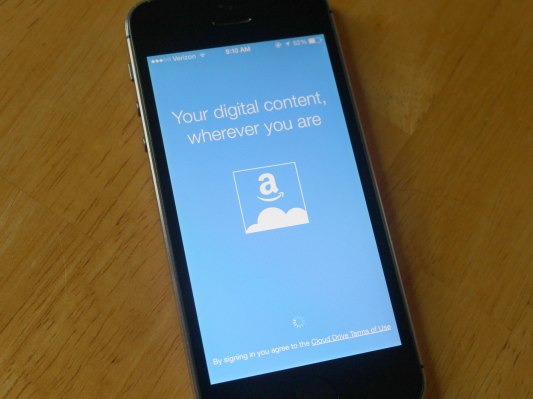Amazon has quietly expanded its Cloud Drive service – a competitor to Dropbox, Google Drive and other online file hosting services – to mobile platforms, with the release of dedicated apps on iTunes, Google Play, and the Amazon Appstore. The apps offer a simplified folder list and a way to view and share files, as well as play the music and videos you have stored on Cloud Drive.
The Android versions of the apps arrived in their respective stores in late June, but the iOS version just went live over the holiday weekend here in the U.S. Amazon has yet to make a formal announcement about their debut.
Amazon already offers desktop (Mac and PC) apps for Cloud Drive, but on mobile, it instead introduced apps for working with specific aspects of its cloud service. For example, Amazon today has Cloud Drive Photos, which works to automatically upload your smartphone’s photos into Cloud Drive, as well as organize them. That app is available on iOS and Android, and the service is also built into Amazon’s Fire Phone.
It also used to offer Amazon Cloud Player, a free app for streaming your music hosted on its Cloud Drive service. (Cloud Player has since been rebranded Prime Music and now includes a Pandora-like streaming service in addition to its Cloud Drive-powered streaming functions).
With the new, standalone Cloud Drive apps, though, the focus is more on productivity. The apps will reflect the folder set up you have established on Cloud Drive, which may include folders like “Pictures,” “Videos,” or “My Send-to-Kindle Docs,” among others. From these folders, you’re able to drill down and then open and view supported files – documents, spreadsheets, presentations, and photos. You’re not able to edit these files, however.
The Cloud Drive app also lets you share the files as links and attachments through emails and messages. Or you can grab a link to a file if you want to share it publicly, like posting it on social media, for example.
In addition to the file viewing capabilities, you’re able to stream the music and videos you have stored on Cloud Drive, but it’s not an elegant interface for this – you’d be better off using the Prime Music app for playing your songs.
[gallery ids="1178913,1178915,1178914,1178916"]
The new apps themselves are fairly bare bones today in terms of their overall feature set – nothing that should worry productivity software and cloud hosting companies, including Google, Microsoft or Apple – at least, for now. But Amazon’s expansion of its Cloud Drive service to mobile could hint that the company has larger ambitions around this service for the long-term.
That being said, Amazon still has a lot of catching up to do if it wants to truly compete on this front. These mobile apps currently don’t offer editing, but they also don’t support a number of basic features, like uploads from mobile, automatic syncing, the ability to move files or edit their metadata, among other things.
Where Amazon does have an advantage is price: Amazon’s Unlimited Everything plan lets you store everything in its cloud for just $60 per year. Its Unlimited Photos service is even cheaper at $11.99 per year. Services like Google Drive and Dropbox are much pricier when you start getting up into the terabytes of storage space. Plus, Dropbox individual accounts are capped at 1 TB.
Amazon tells us it plans to keep the pricing the same as it expands its service to mobile, and it will also continue to invest in both the Cloud Drive and Cloud Drive Photos apps going forward.
The launch of the standalone Cloud Drive apps follows that of the Cloud Drive developer SDKs for Android and iOS in June. In its announcement, Amazon referenced a small handful of third-party apps that had been built using the new SDKs, which are also listed on the Amazon Cloud Drive website. The company did not mention its own Cloud Drive apps at the time, but they’re now appearing on the Cloud Drive homepage.
However, although the Cloud Drive app does utilize some functionality of the SDK, it was custom-built by Amazon’s own development team – it’s only appearing in the Cloud Drive App Gallery because that’s where all the apps that support Cloud Drive are listed.
